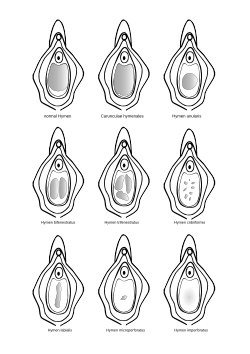
Back Maagdevlies Afrikaans غشاء البكارة Arabic هايمن ARZ Qızlıq pərdəsi Azerbaijani Дзявочая плява Byelorussian Дзявоцкая балона BE-X-OLD Девствена ципа Bulgarian যোনিচ্ছদ Bengali/Bangla Lienenn-gourzh Breton Himen (biologija) BS
| Hymen | |
|---|---|
 Various hymen defects (the shaded areas represent the vaginal opening) | |
 External genitals of a human female | |
| Details | |
| Identifiers | |
| Latin | hymen |
| Greek | ὑμήν |
| MeSH | D006924 |
| TA98 | A09.1.04.008 |
| TA2 | 3530 |
| FMA | 20005 |
| Anatomical terminology | |
The hymen is a thin piece of mucosal tissue that surrounds or partially covers the vaginal introitus. A small percentage are born with hymens that are imperforate and completely obstruct the vaginal canal. It forms part of the vulva and is similar in structure to the vagina.[1][2] The term comes straight from the Greek, for 'membrane'.
In children, a common appearance of the hymen is crescent-shaped, although many shapes are possible. Each shape in the natural range has a Latinate name. During puberty, estrogen causes the hymen to change in appearance and become very elastic.[3][4] Normal variations of the post-pubertal hymen range from thin and stretchy to thick and somewhat rigid.[1] Very rarely, it may be completely absent.[5]
The hymen can rip or tear during first penetrative intercourse, which usually results in pain and, sometimes, mild temporary bleeding or spotting. Minor injuries to the hymen may heal on their own, and not require surgical intervention.[6] Historically, it was believed that first penetration was necessarily traumatic, but now sources differ on how common tearing or bleeding are as a result of first intercourse.[7][8][9] Therefore, the state of the hymen is not a reliable indicator of virginity,[2][10] though "virginity testing" remains a common practice in some cultures, sometimes accompanied by hymen reconstruction surgery to give the appearance of virginity.
- ^ a b Cite error: The named reference
emanswas invoked but never defined (see the help page). - ^ a b Perlman, Sally E.; Nakajyma, Steven T.; Hertweck, S. Paige (2004). Clinical protocols in pediatric and adolescent gynecology. Parthenon. p. 131. ISBN 978-1-84214-199-1.
- ^ Cite error: The named reference
:1was invoked but never defined (see the help page). - ^ Cite error: The named reference
:2was invoked but never defined (see the help page). - ^ Mishori, R.; Ferdowsian, H.; Naimer, K.; Volpellier, M.; McHale, T. (June 3, 2019). "The little tissue that couldn't – dispelling myths about the Hymen's role in determining sexual history and assault - Fact 1A". Reproductive Health. 16 (1): 74. doi:10.1186/s12978-019-0731-8. PMC 6547601. PMID 31159818.
- ^ Hegazy, Abdelmonem; Al-Rukban, Mohammed (January 1, 2012). "Hymen: Facts and conceptions". The Health. 3 (4). ISSN 2219-8083.
Possible explanations for the lack of genital trauma include... acute injuries occur but heal completely.
- ^ "The Hymen". University of California, Santa Barbara. Retrieved September 19, 2020.
While some females bleed the first time they have penetrative intercourse, not every female does. This depends on many factors, such as how much hymenal tissue a female has, whether her hymen has already been stretched or torn, or how thick and elastic it is.
- ^ Rogers, Deborah J; Stark, Margaret (August 8, 1998). "The hymen is not necessarily torn after sexual intercourse". BMJ: British Medical Journal. 317 (7155): 414. doi:10.1136/bmj.317.7155.414. ISSN 0959-8138. PMC 1113684. PMID 9694770.
- ^ Emma Curtis, Camille San Lazaro (February 27, 1999). "Appearance of the hymen in adolescents is not well documented". BMJ: British Medical Journal. 318 (7183): 605. doi:10.1136/bmj.318.7183.605. PMC 1115047. PMID 10037658.
We agree with Rogers and Stark that so called rupture and bleeding of the hymen is not to be routinely expected after first sexual intercourse.
- ^ Cite error: The named reference
Knightwas invoked but never defined (see the help page).